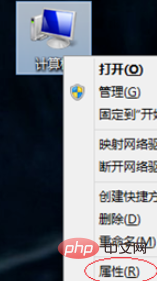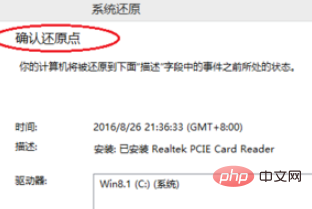 Operation and Maintenance
Operation and Maintenance
 Windows Operation and Maintenance
Windows Operation and Maintenance
 How to restore environment variables to default values
How to restore environment variables to default values
How to restore environment variables to default values

Right-click Computer--Properties

Select Advanced System Settings

Switch to System Protection

Select System Restore





The above is the detailed content of How to restore environment variables to default values. For more information, please follow other related articles on the PHP Chinese website!

Hot AI Tools

Undresser.AI Undress
AI-powered app for creating realistic nude photos

AI Clothes Remover
Online AI tool for removing clothes from photos.

Undress AI Tool
Undress images for free

Clothoff.io
AI clothes remover

AI Hentai Generator
Generate AI Hentai for free.

Hot Article

Hot Tools

Notepad++7.3.1
Easy-to-use and free code editor

SublimeText3 Chinese version
Chinese version, very easy to use

Zend Studio 13.0.1
Powerful PHP integrated development environment

Dreamweaver CS6
Visual web development tools

SublimeText3 Mac version
God-level code editing software (SublimeText3)

Hot Topics
 1378
1378
 52
52
 Details on how to turn on environment variable settings on Windows 11
Dec 30, 2023 pm 06:07 PM
Details on how to turn on environment variable settings on Windows 11
Dec 30, 2023 pm 06:07 PM
The environment variable function is an essential tool for running the configuration program in the system. However, in the latest win11 system, there are still many users who do not know how to set it up. Here is a detailed introduction to the location of the win11 environment variable opening. Come and join us. Learn to operate it. Where are the win11 environment variables: 1. First enter "win+R" to open the run box. 2. Then enter the command: controlsystem. 3. In the system information interface that opens, select "Advanced System Settings" from the left menu. 4. Then select the "Environment Variables" option at the bottom of the "System Properties" window that opens. 5. Finally, in the opened environment variables, you can make relevant settings according to your needs.
 How to configure python environment variables in Win11? Tips for adding environment variables in win11python
Feb 29, 2024 pm 04:30 PM
How to configure python environment variables in Win11? Tips for adding environment variables in win11python
Feb 29, 2024 pm 04:30 PM
Win11 system is the latest Windows operating system, and users may encounter some configuration problems when using it. Among them, configuring Python environment variables is a common requirement because it allows users to easily use Python commands from any location. This article will introduce how to configure Python environment variables in Win11 system so that users can use the Python programming language more conveniently. 1. [Right-click] this computer on the desktop, and select [Properties] in the menu item that opens; 2. Then, under related links, find and click [Advanced System Settings]; 3. In the system properties window, click [Environment] at the bottom Variables]; 4. In the environment variables window, under system variables, select [Path], and then click
 Steps to set the PATH environment variable of the Linux system
Feb 18, 2024 pm 05:40 PM
Steps to set the PATH environment variable of the Linux system
Feb 18, 2024 pm 05:40 PM
How to set the PATH environment variable in Linux systems In Linux systems, the PATH environment variable is used to specify the path where the system searches for executable files on the command line. Correctly setting the PATH environment variable allows us to execute system commands and custom commands at any location. This article will introduce how to set the PATH environment variable in a Linux system and provide detailed code examples. View the current PATH environment variable. Execute the following command in the terminal to view the current PATH environment variable: echo$P
 How to configure Tomcat environment variables
Oct 26, 2023 am 10:41 AM
How to configure Tomcat environment variables
Oct 26, 2023 am 10:41 AM
To configure Tomcat environment variables, you need to add the CATALINA_HOME variable to the system and add the Tomcat installation path to the PATH variable. The steps in Windows are to first download and install Tomcat, open the system properties window, open the environment variable settings, add the Tomcat environment variable, modify the Path variable and verify the configuration. The steps in Linux are to first download and install Tomcat, open a terminal window, edit the bashrc file, add Tomcat environment variables, etc.
 Windows 10 environment variable setting tutorial
Jul 15, 2023 pm 06:09 PM
Windows 10 environment variable setting tutorial
Jul 15, 2023 pm 06:09 PM
Environment variables are an important setting in the operating system, but some Windows 10 users still don’t know how to set environment variables. In fact, the method is very simple. Open the run window, call up the system characteristics window through the sysdm.cpl command, and then switch to the advanced tab. You will see a button for environment variables. Click this button to enter the setting of environment variables. interface, and then just set it up according to actual needs. How to set environment variables in Windows 10: 1. First open the run window on the computer, then enter sysdm.cpl in the window and press Enter. 2. Select Advanced in the system properties interface, and then click Environment Variables. 3. Here we can see the variables displayed, and we can create a new one on a single machine.
 How to solve the problem that Java environment variable configuration does not take effect
Feb 19, 2024 pm 10:57 PM
How to solve the problem that Java environment variable configuration does not take effect
Feb 19, 2024 pm 10:57 PM
How to solve the problem that Java environment variables do not take effect after configuration. During the Java development process, we often need to configure Java environment variables to ensure the normal operation of the program. However, sometimes we encounter some strange problems. Even if the Java environment variables are configured correctly, we find that the program does not run as configured. This is actually a common problem, and this article will introduce some solutions and provide specific code examples. The root cause of the problem is that the configuration of Java environment variables does not take effect correctly. Here are some common
 How to set conda environment variables
Dec 05, 2023 pm 01:42 PM
How to set conda environment variables
Dec 05, 2023 pm 01:42 PM
Conda environment variable setting steps: 1. Find the installation path of conda; 2. Open the "System Properties" dialog box; 3. In the "System Properties" dialog box, select the "Advanced" tab, and then click the "Environment Variables" button; 4. In the "Environment Variables" dialog box, find the "System Variables" section, and then scroll to the "Path" variable; 5. Click the "New" button, and then paste the conda installation path; 6. Click "OK" to save the changes; 7. Verify whether the setting is successful.
 Simple and easy-to-understand PyCharm environment variable configuration guide
Feb 21, 2024 pm 03:03 PM
Simple and easy-to-understand PyCharm environment variable configuration guide
Feb 21, 2024 pm 03:03 PM
PyCharm is a powerful Python integrated development environment (IDE) that provides a wealth of functions and tools to help developers improve work efficiency. In PyCharm, you can easily manage the configuration information in the project by configuring environment variables. This article will introduce how to configure environment variables in PyCharm. I hope it will be helpful to beginners and developers. 1. The steps to configure environment variables in PyCharm are as follows: Open your PyCharm project and go to the project page



